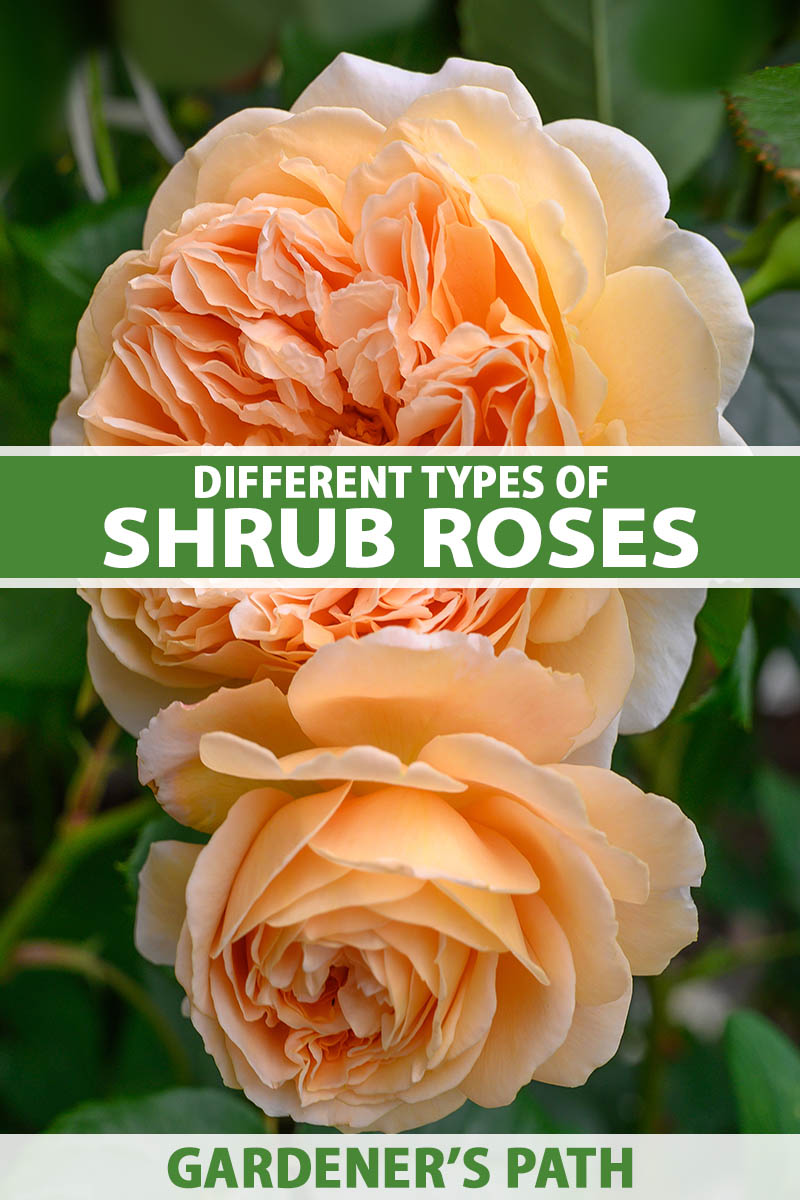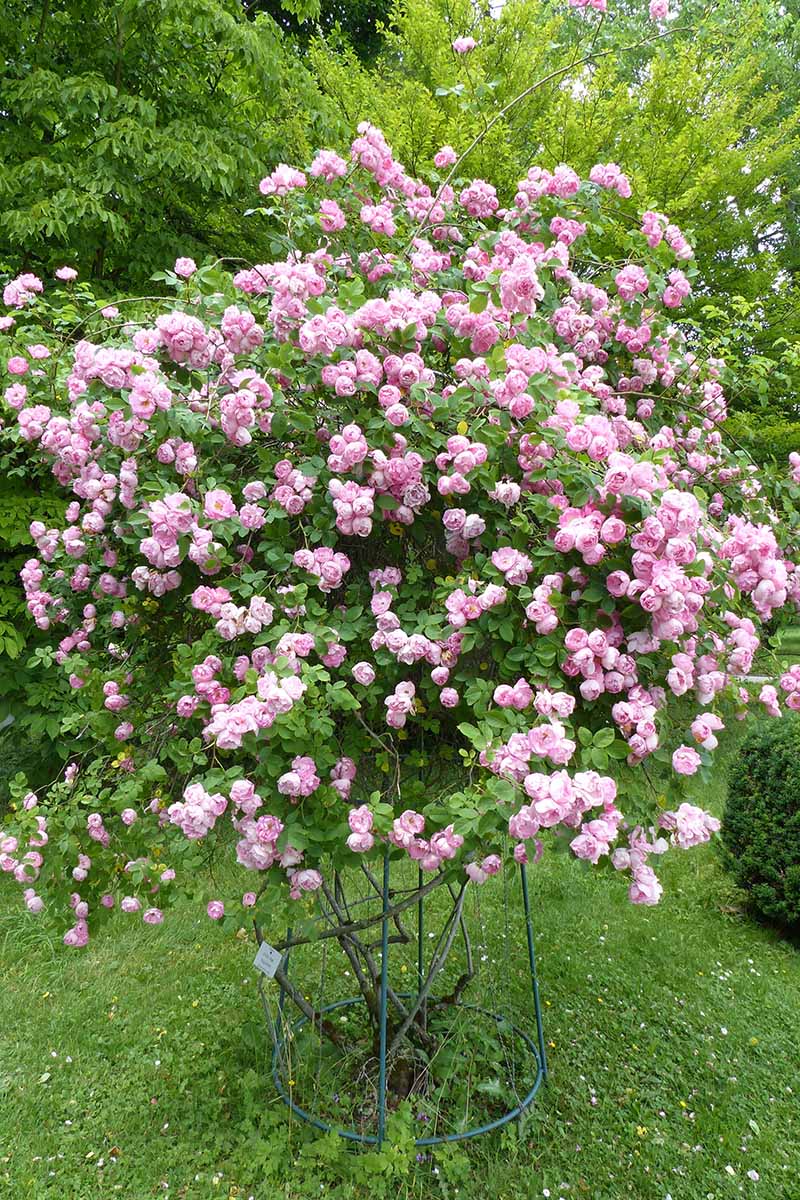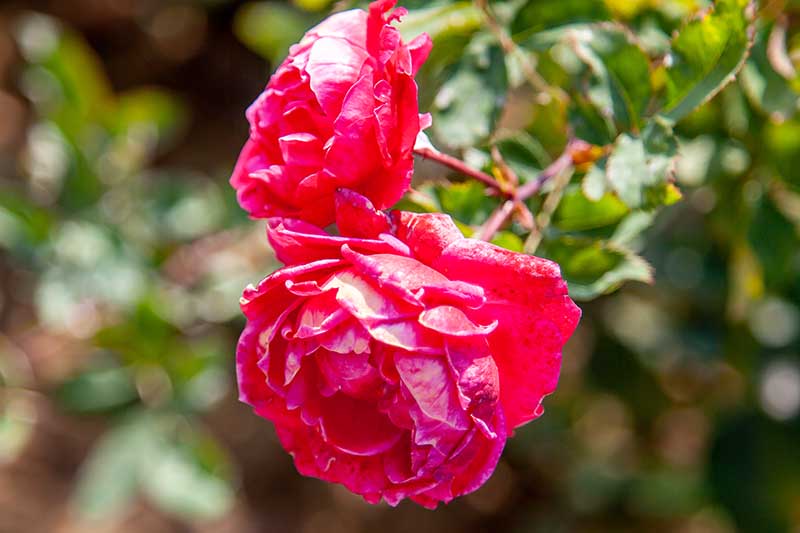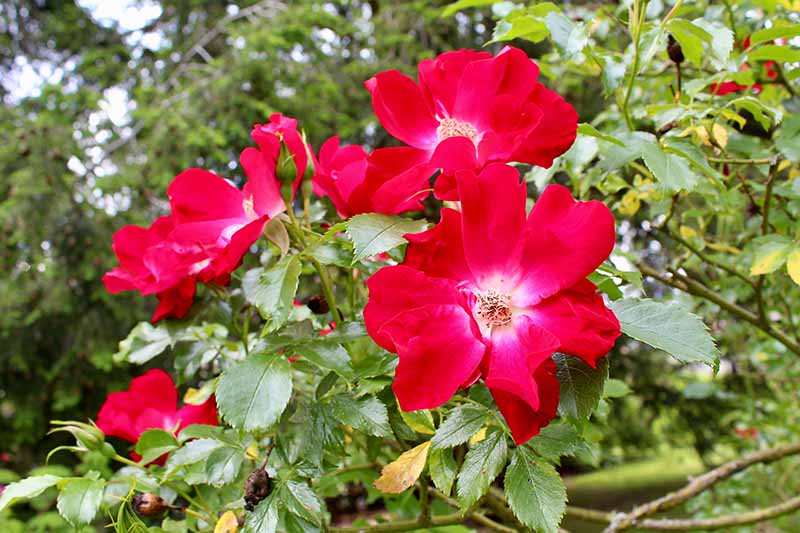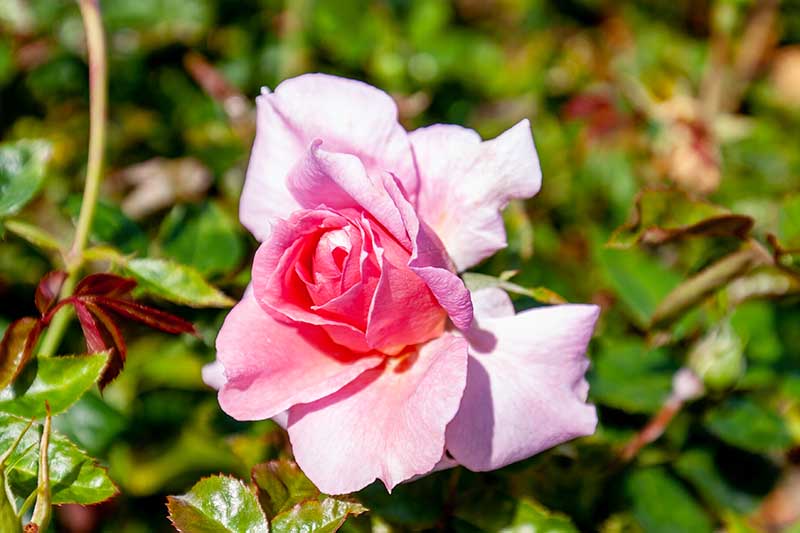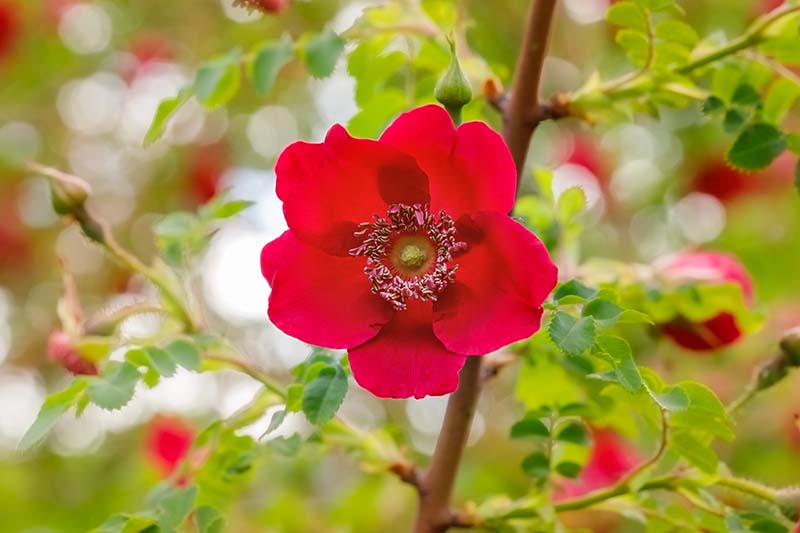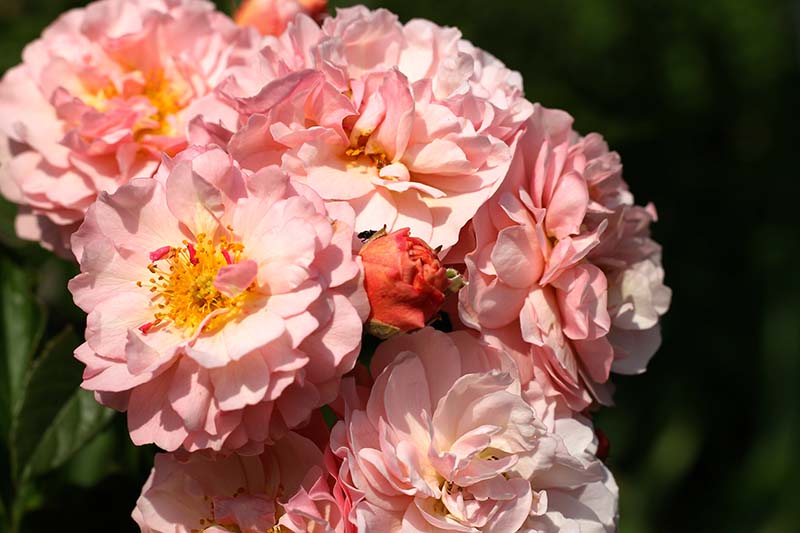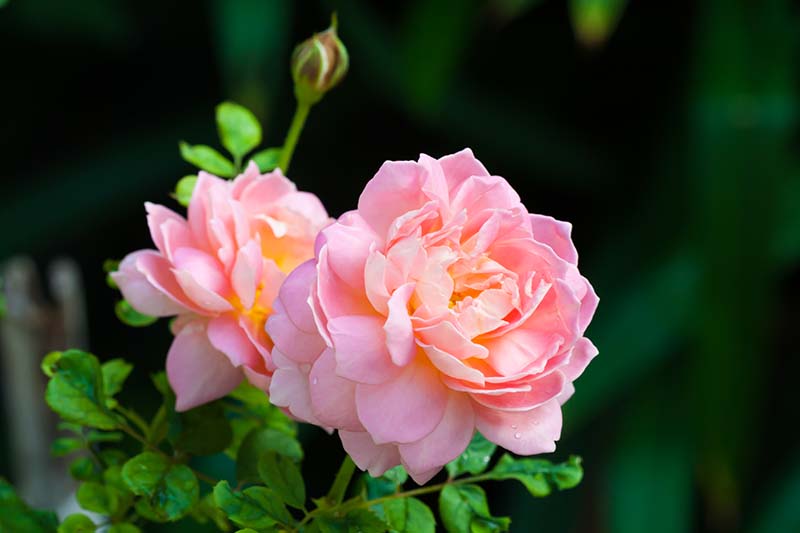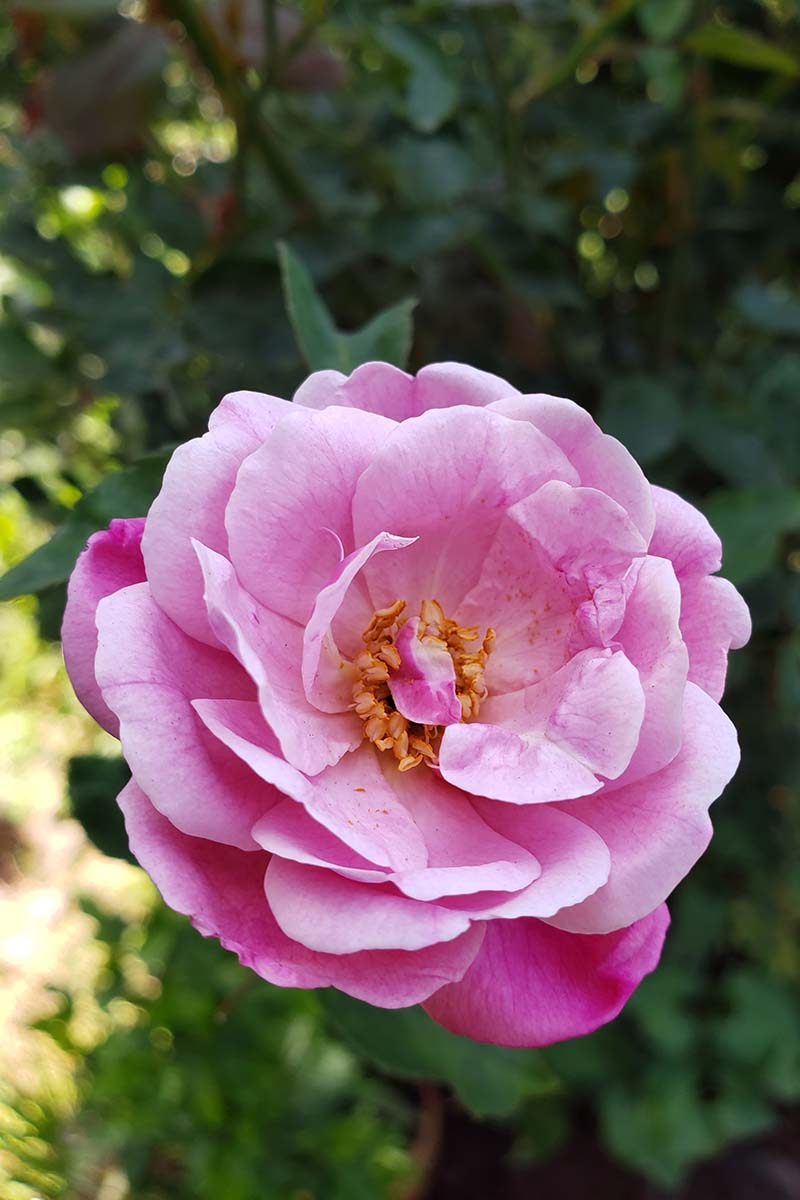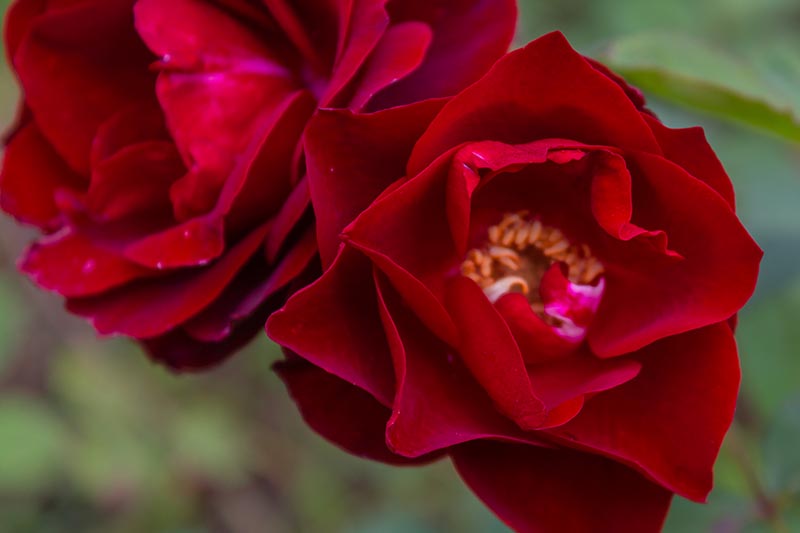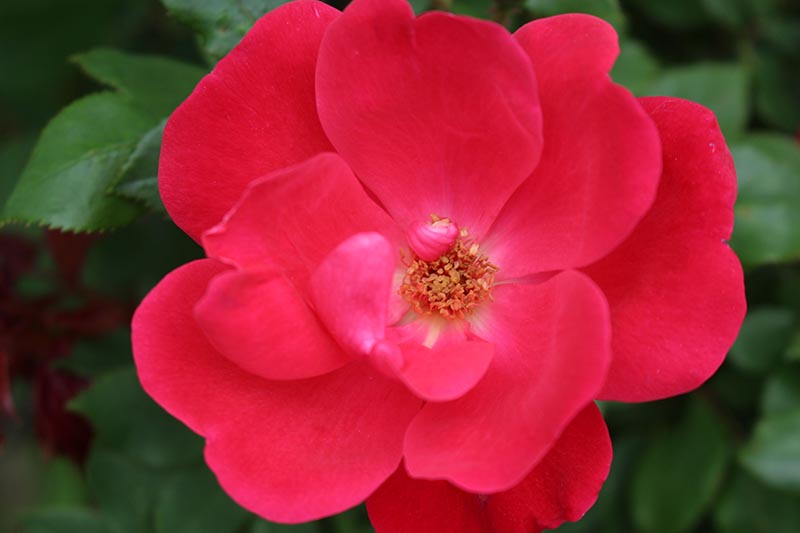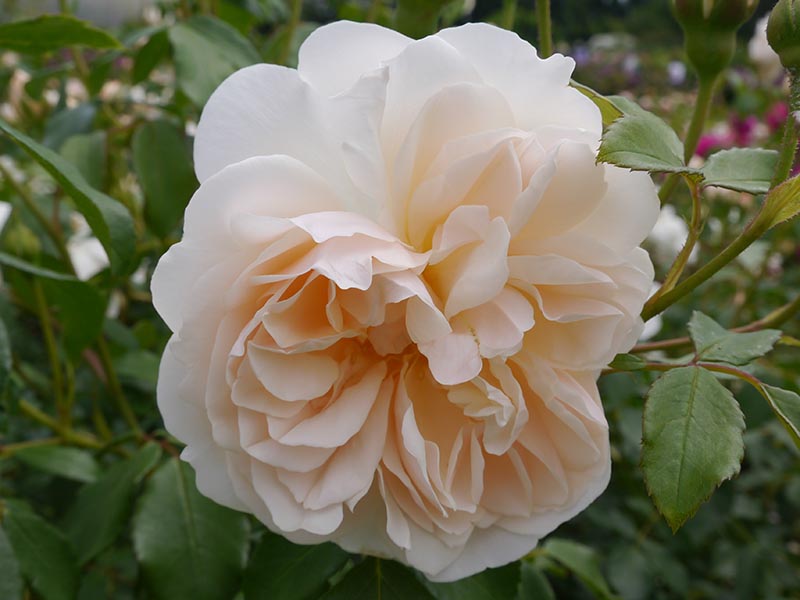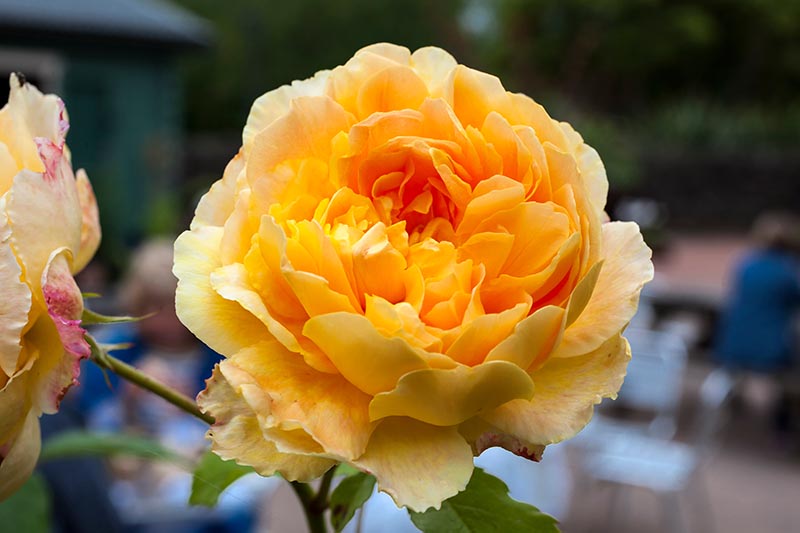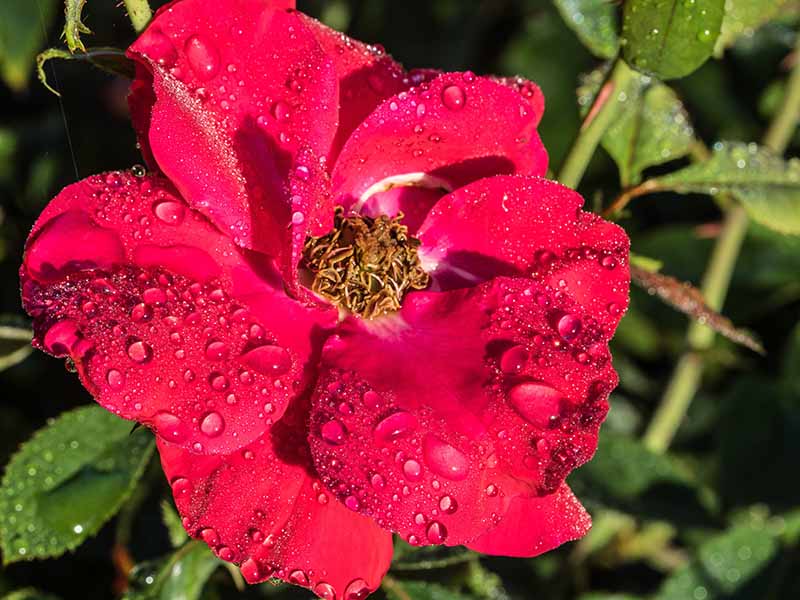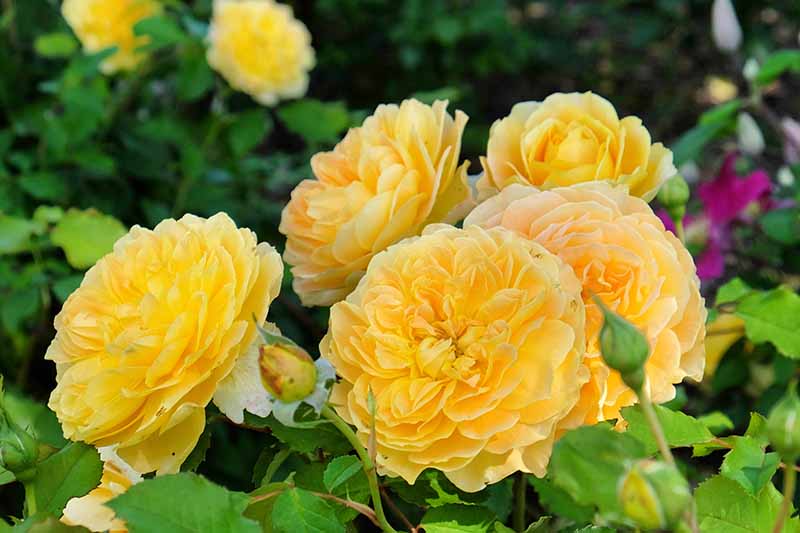They come in an endless range of colors, shapes, and sizes, from ones with tiny blossoms that have just a few petals to massive blooms with over a hundred petals each. In other words, this is one eclectic collection of plants. And I’ll be honest: we haven’t figured out a really good way to categorize them all. We link to vendors to help you find relevant products. If you buy from one of our links, we may earn a commission. Shrub roses, also known as landscape roses, are a group of modern types including varieties that don’t fall under any of the other available classifications. Basically, it’s a catch-all grouping that includes ground covers, climbers, and everything in between. Shrub types are incredibly popular, and helped bring Rosa species to a wider audience. Ever heard of David Austin, English, or Knock Outs? These are all in the shrub category. In fact, the majority of the plants you’ll find at those big home stores are shrubs. And when I take a stroll around my neighborhood, most of the roses I spot are shrubs. They’re everywhere! But how do you know which is which, since a rose with a shrublike growth habit isn’t necessarily a shrub rose? If you’re feeling confused, don’t worry! We’re going to help make sense of this group of plants, so that you’ll have a better understanding of what people mean when they refer to shrub roses. Here’s what we’ll discuss: Take off the gardening gloves, pull up a cup of tea, and let’s dive into the wild, wondrous world of shrub roses.
What Is a Shrub Rose?
I can guess what you’re thinking: Aren’t all roses shrubs? Well, yes. From a botanical perspective, all Rosa species are indeed shrubs. But when we talk about “shrub roses,” we actually mean a certain grouping. Huh? First, all types are grouped into one of three categories, according to the American Rose Society (ARS), which oversees the classification of these plants around the globe. These main categories are old garden, modern, and species. You can learn more about these groupings and how a species is put into a group in our guide to rose classifications. All shrubs fall under the modern grouping, and “shrub” is kind of a catch-all group for any that doesn’t fit into another modern classification. Shrub was an insignificant category with just a few plants in it, until well-known breeder David Austin came along. When he started breeding his plants, he registered them with the ARS under the little-used shrub category. Some people refer to Austin’s plants as English roses, but officially, they’re categorized as shrubs. After his plants started becoming popular, other breeders started registering their specimens in the same category, and the shrub category became the most commercially popular of all the classifications. To further confuse the issue, there are both classic and modern shrubs. Classics can be further sub-classified as hybrid kordesii, hybrid moyesii, hybrid musk, or hybrid rugosa, which are all hybrids that were bred out of old world species. Then there’s the modern shrub sub-category, which includes anything that doesn’t fit in the classic category. But don’t confuse the classic shrub classification with the term “classic roses.” Some people use the term “classic” to refer to old garden species and hybrids. To be clear, the term “shrub” doesn’t necessarily describe growth habit. There are low-growing, ground cover shrub roses, and there are climbing types that reach up to 15 feet tall. Shrubs are generally hardier, tougher, and easier to grow than old garden types, which can be finicky. But they’re less resistant to pests and diseases than species (or wild) types. They can handle humid conditions as well as temporarily arid conditions and brief periods of drought. The size of the blossoms are somewhere in between those of old garden and species types. The blossoms usually grow in groupings rather than singles. In other words, they combine a lot of the characteristics of old and species roses, such as the showy, dramatic blooms of old gardens, and the easy care of species. While they were bred to do well in the garden with consistent and pretty blossoms, you usually won’t find those massive, elegant flowers like you’ll find on tea rose bushes. But life’s about compromise, right?
Sub-Classifications
Let’s break down the various subcategories so that we can really have a good understanding of what this classification encompasses. I’ll also recommend a few different stand-out options from these subclassifications, in case you’re in the market for some exceptional specimens.
Hybrid Kordesii
Hybrid kordesii (Rosa kordesii) are commonly known as Kordes. They were hybridized in the early to mid-1900s at a German nursery called The House of W. Kordes Sohne, which was founded by Wilhelm Kordes in 1887, in the city of Elmshorn. By the mid-1900s, they were one of the largest rose suppliers and breeders in Europe. These hybrids were later refined by Dr. Felicitas Svejda in the 1960s, who developed the Canadian Explorer Series by using these hybrids and also hybrid rugosas. Svejda was a federal scientist in Canada who wanted to create a plant that could survive Canada’s notoriously cold winters. If you’re looking for a winter hardy rose that is tough and has exceptional disease resistance, these are a good option. Most are hardy down to Zone 3. Here are a few noteworthy R. kordesii options:
Alexander MacKenzie
‘Alexander MacKenzie’ is part of the Canadian Explorer series, named for the Canada-born explorer who is credited as being the first European descendant to cross the North American continent from the east to west. This plant grows to about six feet tall, or taller in ideal growing conditions, and is absolutely covered in the summer from head to toe in vibrant, double, raspberry red blossoms. Hardy in Zones 4-9, this plant can survive in Zone 3 with winter protection.
Dortmund
This well-loved single-blossom plant is a stand-out Kordes climber. The flower has deep red petals with a white eye, and they appear on the plant from mid-spring to frost. It grows up to 10 feet tall and features glossy, deep green foliage. With yearly pruning, you can grow it as a freestanding shrub at about six feet tall. This plant needs regular deadheading to blossom all season long. If you like to harvest the hips, this has large orange ones, which not only have a good flavor but add winter color and interest to the garden as well. It’s hardy down to Zone 5.
Lambert Closse
Another one from the Canadian Explorer series, you might mistake ‘Lambert Closse’ for a hybrid tea because of its large, frilly, double, bright pink blossoms with 54 petals. It blooms all summer long and into the fall. This plant, the result of a ‘John Davis’ kordesii being crossed with an ‘Arthur Bell’ floribunda, stays compact at just three feet tall when mature, and is hardy down to Zone 3.
Hybrid Moyesii
Hybrid moyesii plants were bred from hardy species roses known as Moyes (R. moyesii), which are native to western China. These were crossed with old garden hybrids and species to create various new hybrids. The plants reached the US market in the early 1900s. These plants are extremely disease resistant, except to black spot, which may cause issues in humid areas. Most are hardy to Zone 3 or 4 and have small prickles. They all feature large orange hips and fern-like foliage that stands out from that of other species.
Geranium
This is one of the most popular hybrid moyesii varieties out there, and “Botanica’s Roses” calls it one of the best moyesii for the garden because it stays compact and doesn’t require much by way of maintenance. ‘Geranium’ has bright red, single blossoms on long stems. It’s extremely pest and disease resistant, and grows to about eight feet tall. Botanica’s Roses The hips are just as noteworthy as the flowers, which is great, since these only flower once and then they’re done for the season. The hips are large, glossy, and red with a bottle-like shape.
Highdownensis
‘Highdownensis’ is another one of the most well-known moyesiis varieties. With bright crimson single blossoms, the climbing plants reach about eight feet long when mature. The large, bottle-shaped hips are bright orange and red. This hybrid can handle poor soil, drought, and is disease and pest resistant, so if you dreamed of having these beautiful flowers but your microenvironment isn’t ideal, now’s your chance. This plant won the RHS Award of Garden Merit in 1994.
Hybrid Musk
Hybrid musks are hybrids of the original musk species (R. moschata). Musks are known for their intense, heady scent that is used in perfumes, candles, and cosmetics. But they’re also known for being a bit – okay, extremely – fussy. In the early 1900s, breeders worked to create a hybrid that smelled great but had more disease resistance. Enthusiast Reverend James Pemberton is credited with breeding the first of these hybrids. These grow and bloom in partial sun conditions and many are nearly thornless. They can be climbers or shrubs that grow between four and six feet tall. They are tough, hardy, and disease resistant. Most are hardy to Zone 5 and have long, graceful canes, which makes them perfect for cutting. On a personal note, hybrid musks are some of my favorites because they are beautiful, fragrant, and don’t take too much work to keep them healthy and productive.
Cornelia
Released in 1925, ‘Cornelia’ is pest and disease resistant, even in high humidity. Depending on the heat and sun exposure that it receives, the large, double blossoms can range from pale pink to deep salmon. It’s best grown as a climber since the thornless canes grow up to 12 feet tall, though you can prune it to maintain it as a shrub. It also looks gorgeous crawling down walls. Hardy to Zone 6, this plant should be put somewhere where it won’t be hit with a ton of wind. It received an RHS Award of Garden Merit in 1993.
Felicia
‘Felicia’ is an absolutely fabulous flower, which is no doubt the reason that it won the National Rose Society Certificate of Merit in 1927, and the RHS Award of Garden Merit in 1993. The massive, frilly double blossoms are highly fragrant and dark to pale pink, with the petals gradually fading from dark to light from the center to the exterior of the blossom. They also have a strong, heady fragrance and lend themselves nicely to cutting. The plant starts out in the spring with a massive burst of flowers before tapering off to a smaller flush of blossoms in the summer. Once fall arrives, you will have the biggest and longest-lasting flowers of the growing season, followed by large, round hips. Hardy to Zone 5, the graceful, arching canes are nearly thornless, multi-branched, and they can grow up to 10 feet tall. This cultivar may be grown as a shrub or trained as a climber.
Pink Prosperity
‘Pink Prosperity’ is a stunner even when it isn’t in full bloom. The buds are deep, dark red before opening and fading to medium pink. The petals on the exterior are darker pink, while the interior petals are lighter. Pest and disease resistant, the plants can handle poor soil, drought, and will blossom even in nearly full shade. This cultivar is hardy to Zone 4.
Hybrid Rugosa
Rugosas are known for being very cold hardy, highly fragrant, and highly resistant to black spot. The most common commercial rugosas are in the Parkland series. Most hybrid rugosas have either single or double blossoms that bloom repeatedly throughout the growing season, and large hips. They can handle light shade and some drought. Whether hybrid or otherwise, rugosas don’t do well with pesticides, so avoid spraying any chemicals on the foliage. These hybrids were created by crossing R. rugosa with other species. By the way, rugosa means wrinkled, a reference to the plant’s wrinkled, deeply-veined foliage. Typically, the leaves are deep, glossy green, which creates a beautiful contrast to the flowers.
Hope for Humanity
This gorgeous hybrid is part of the Parkland series and has blood red petals on double blossoms. The canes grow up to 10 feet tall, but it stays smaller in cooler climates. Speaking of which, this plant is hardy to Zone 3. It can even grow in Zone 2, though it will die back in the winter there.
Jens Munk
Remember the Canadian Explorer series? This is part of that series as well, but with rugosa rather than kordesii parentage. The bush can tolerate part shade and reaches about four feet tall when mature, with a compact, mound-like growth habit. Don’t be surprised by the shape when this plant is young. It’s gangly and leggy for the first few years, but it fills out after it matures. And it’s hardy down to Zone 2(!!). The fragrant semi-double blossoms are bright candy pink with yellow centers. This is a vigorous grower and bloomer that is extremely resistant to disease.
Linda Campbell
‘Linda Campbell,’ also known as ‘Tall Poppy,’ was bred by famed rosarian Ralph Moore, who is known as the “king of miniature roses.” This is an intensely prolific plant that blossoms with heavily scented, dark raspberry or deep red single blossoms. Each flower is fairly small, but the bush grows up to six feet tall and it’s absolutely covered in blooms from mid-spring to fall. Hardy in Zones 3 to 8, this cultivar is extremely disease resistant.
Shrub
This sub-category is a catch-all for shrubs that don’t fit in one of the groupings listed above. Remember that these are considered “modern” shrubs. David Austin and the Knock Outs are perhaps the most well-recognized varieties from this category, but there are lots more. Also look for Griffith Buck and Harkness shrubs. Dr. Griffith Buck was a professor at Iowa State University and a horticulturalist who bred roses that could thrive without pesticides or fungicides, and that could survive Iowa’s cold winters and humid summers. Harkness is a nursery based in England that is working to create hardy, pest-resistant, and disease-resistant plants. And by the way, if you’ve ever heard the term “English rose,” that’s one bred by David Austin. They are practically an entire category unto themselves, but they’re all officially categorized as shrubs.
Knock Out
There are miniature Knock Outs, pink and yellow Knock Outs, and double blossom Knock Outs, but this is the O.G. This red, single blossom has hot pink or cherry red flowers that appear from spring to fall. This is the flower that raised the bar for breeders in terms of maintenance.
Lichtkönigin Lucia
This German-bred hybrid is called “probably the most underrated yellow shrub that has ever been raised,” according to “Botanica’s Roses.” No wonder it has become a standard in the rose world! Knock Out If you want to bring this garden staple home – and I highly recommend you do if you are just beginning with Rosa spp. – head to Burpee to pick up a bare root plant. Or find tips on growing them here.
Lichfield Angel
‘Lichfield Angel’ is absolutely heavenly, with pale peach to cream blossoms that have over 100 petals. With long, nearly thornless stems perfect for cutting, if you want to fill your home with vases of creamy, musk-scented blossoms, this is one of the absolute best options. And it’s a winner not just because the flowers are beautiful, but because the plants are fairly easy to care for too. They’re vigorous growers, can handle partial sun, and are fairly disease resistant. ‘Lichfield Angel’ This cultivar grows up to five feet tall in Zones 5-9. Again, our friends at Burpee carry this exceptional option in bare roots. This vibrant, vigorous plant has massive clusters of double blossoms that seem to glow in the sun. No wonder it earned the name “Lucia, Queen of Light,” or that it has maintained its status as a winner of the German rose trials, the Allgemeine Deutsche Rosenneuheitenprüfung (ADR), since 1968. It’s one of the few to maintain this status for that long. It’s fragrant, hardy to Zone 5, healthy, disease-resistant, and a constant bloomer all summer long.
Molineux
This award-winner is a cheerful addition to the garden thanks to its vibrant yellow blossoms, which have 120 petals. This stand-out specimen won the RHS Garden of Merit Award in 2002.
How to Care for Shrub Roses
Now that we technically know what they are, does caring for shrubs differ from what’s involved with other roses? It smells and looks like a tea rose without the fussiness of a tea, since it is drought tolerant and disease resistant. ‘Molineux’ Make this a part of your garden by visiting Burpee, where you can pick up a bare root plant.
Wiltshire
‘Wiltshire’ is a ground cover type with clusters of vibrant pink blossoms. It also makes a stunning addition to rock gardens or trailing over walls. The highly fragrant double flowers appear all growing season long. This flower has earned multiple awards, including the Royal National Rose Society Certificate of Merit in 1991, and the Glasgow Certificate of Commendation in 1994. It stays under a foot tall, thrives down to Zone 4, and is disease resistant. Only in that they can be planted in a wider range of environments, and don’t need as much maintenance as some other types. (Hooray!) All shrub types do well in full sun and well-draining soil, but some can be grown in partial sun or partial shade. Most can handle brief drought, but don’t let them remain too dry for too long. Water them whenever the top inch of soil has dried out. While many will keep blooming even if you don’t deadhead them, deadheading will result in more blooms. Others may require deadheading for a second or third flush. They should be pruned back annually in the early spring. Cut the canes back to about a foot or two above the ground, and remove any dead or diseased canes. Thin out any crossing or rubbing canes as well. In the fall, you can lightly trim them back if they’ve become overgrown, but leave the big pruning job for the spring. Check out our guide to guide to growing roses to learn more. This category is incredibly popular and undeniably convoluted. Even nurseries aren’t sure how to label plants in this category. Don’t worry if you head to the store and aren’t certain if what you’re looking for is a shrub rose, or one with a shrublike growing habit. For most of us, we don’t care how it is classified as so long as it grows well, looks lovely in the garden, and ticks all our boxes. It’s all just a name, right? (And a rose by any other, and so on and so forth.) So what do you think? Are you sold on shrub roses? What kind are you planning to plant? Let us know in the comments section below! Hopefully this guide cleared things up for you. If so, you might want to get into the weeds with some of our other comprehensive rose articles next:
13 of the Best Hardy Roses to Grow at HomeEverything You Need to Know About Buying Rose BushesHow to Winterize RosesAll About Rose Growing Habits
